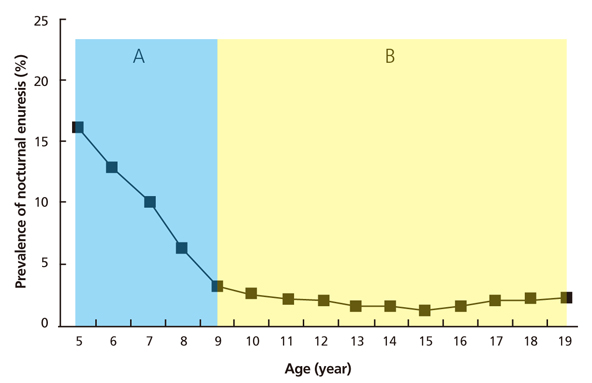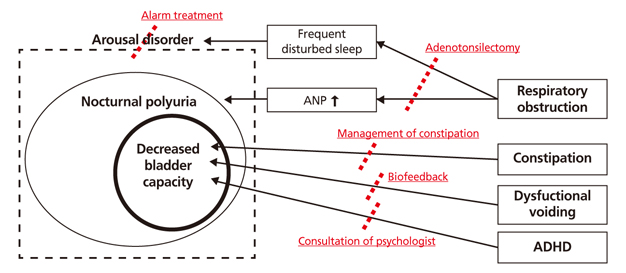J Korean Med Assoc.
2017 Oct;60(10):800-805. 10.5124/jkma.2017.60.10.800.
Management of patients with refractory nocturnal enuresis
- Affiliations
-
- 1Department of Urology, Haeundae Paik Hospital, Inje University School of Medicine, Busan, Korea. H00181@paik.ac.kr
- KMID: 2393525
- DOI: http://doi.org/10.5124/jkma.2017.60.10.800
Abstract
- There are two types of refractory nocturnal enuresis. The first type corresponds to patients who are refractory from initial success, and the second type refers to refractory nocturnal enuresis after long-term success, in patients who cannot discontinue medications for enuresis. In the former type, it is necessary to determine whether the timing of medications is appropriate, whether the usage of antidiuretics is appropriate, whether any lifestyle changes have taken place, and whether there are secondary causes of enuresis. In the latter type, enuretic alarm treatment should be considered initially, and it is then important to investigate whether a respiratory obstruction is present in patients with nocturnal polyuria, whether the patient is constipated, and whether patients with non-monosymptomatic nocturnal enuresis have lower urinary tract symptoms or attention deficit hyperactivity disorder.
Keyword
MeSH Terms
Figure
Cited by 1 articles
-
Current management scheme of nocturnal enuresis
Kwanjin Park
J Korean Med Assoc. 2017;60(10):790-791. doi: 10.5124/jkma.2017.60.10.790.
Reference
-
1. Austin PF, Bauer SB, Bower W, Chase J, Franco I, Hoebeke P, Rittig S, Walle JV, von Gontard A, Wright A, Yang SS, Neveus T. The standardization of termi-nology of lower urinary tract function in children and adolescents: update report from the standardization committee of the International Children's Continence Society. Neurourol Urodyn. 2016; 35:471–481.
Article2. Austin PF, Vricella GJ. Functional dis-orders of the lower urinary tract in child-ren. In : Campdell MF, Walsh PC, Wein AJ, Kavoussi LR, editors. Campbell-Walsh urology. 11th ed. Philadelphia: Elsevier;2016. p. 3297–3316.3. Glazener CM, Evans JH. Desmopressin for nocturnal enuresis in children. Cochrane Database Syst Rev. 2002; (3):CD002112.
Article4. Glazener CM, Evans JH, Peto RE. Drugs for nocturnal enu-resis in children (other than desmopressin and tricyclics). Cochrane Database Syst Rev. 2003; (4):CD002238.
Article5. Caldwell PH, Sureshkumar P, Wong WC. Tricyclic and related drugs for nocturnal enuresis in children. Cochrane Database Syst Rev. 2016; (1):CD002117.
Article6. Glazener CM, Evans JH, Peto RE. Alarm interventions for nocturnal enuresis in children. Cochrane Database Syst Rev. 2005; (2):CD002911.
Article7. Yeung CK, Sreedhar B, Sihoe JD, Sit FK, Lau J. Differences in characteristics of nocturnal enuresis between children and adolescents: a critical appraisal from a large epidemiological study. BJU Int. 2006; 97:1069–1073.
Article8. Forsythe WI, Redmond A. Enuresis and spontaneous cure rate: study of 1129 enuretis. Arch Dis Child. 1974; 49:259–263.9. Jalkut MW, Lerman SE, Churchill BM. Enuresis. Pediatr Clin North Am. 2001; 48:1461–1488.
Article10. Hagglof B, Andren O, Bergstrom E, Marklund L, Wendelius M. Self-esteem in children with nocturnal enuresis and urin-ary incontinence: improvement of self-esteem after treatment. Eur Urol. 1998; 33:Suppl 3. 16–19.
Article11. Neveus T, Eggert P, Evans J, Macedo A, Rittig S, Tekgul S, Vande Walle J, Yeung CK, Robson L. International Children's Continence Society. Evaluation of and treatment for mono-symptomatic enuresis: a standardization document from the International Children's Continence Society. J Urol. 2010; 183:441–447.
Article12. De Guchtenaere A, Van Herzeele C, Raes A, Dehoorne J, Hoebeke P, Van Laecke E, Vande Walle J. Oral lyophylizate formulation of desmopressin: superior pharmacodynamics compared to tablet due to low food interaction. J Urol. 2011; 185:2308–2313.
Article13. Montaldo P, Tafuro L, Rea M, Narciso V, Iossa AC, Del Gado R. Desmopressin and oxybutynin in monosymptomatic noc-turnal enuresis: a randomized, double-blind, placebo-con-trolled trial and an assessment of predictive factors. BJU Int. 2012; 110:E381–E386.
Article14. Berkenwald A, Pires J, Ellsworth P. Evaluating use of higher dose oxybutynin in combination with desmopressin for refra-ctory nocturnal enuresis. J Pediatr Urol. 2016; 12:220.e1–220.e6.
Article15. Lottmann H, Froeling F, Alloussi S, El-Radhi AS, Rittig S, Riis A, Persson BE. A randomised comparison of oral des-mopressin lyophilisate (MELT) and tablet formulations in children and adolescents with primary nocturnal enuresis. Int J Clin Pract. 2007; 61:1454–1460.
Article16. De Bruyne P, De Guchtenaere A, Van Herzeele C, Raes A, Dehoorne J, Hoebeke P, Van Laecke E, Vande Walle J. Phar-macokinetics of desmopressin administered as tablet and oral lyophilisate formulation in children with monosymptomatic nocturnal enuresis. Eur J Pediatr. 2014; 173:223–228.
Article17. Ferrara P, Del Volgo V, Romano V, Scarpelli V, De Gara L, Miggiano GA. Combined dietary recommendations, desmo-pressin, and behavioral interventions may be effective first-line treatment in resolution of enuresis. Urol J. 2015; 12:2228–2232.18. Akan S, Urkmez A, Yildirim C, Sahin A, Yuksel OH, Verit A. Late-onset secondary nocturnal enuresis in adolescents asso-ciated with post-traumatic stress disorder developed after a traffic accident. Arch Ital Urol Androl. 2015; 87:250–251.
Article19. Neveus T, Leissner L, Rudblad S, Bazargani F. Respiration during sleep in children with therapy-resistant enuresis. Acta Paediatr. 2014; 103:300–304.
Article20. Everaert K, Pevernagie D, Oosterlinck W. Nocturnal enuresis provoked by an obstructive sleep apnea syndrome. J Urol. 1995; 153:1236.
Article21. Neveus T. Pathogenesis of enuresis: towards a new under-standing. Int J Urol. 2017; 24:174–182.
Article22. Park S, Lee JM, Sim CS, Kim JG, Nam JG, Lee TH, Han MW, Kwon JK, Lee JC. Impact of adenotonsillectomy on nocturnal enuresis in children with sleep-disordered breathing: a prospective study. Laryngoscope. 2016; 126:1241–1245.
Article23. Kovacevic L, Lu H, Wolfe-Christensen C, Abdulhamid I, Thottam PJ, Lulgjuraj M, Madgy DN, Lakshmanan Y. Adeno-tonsillectomy normalizes hormones and urinary electrolytes in children with nocturnal enuresis and sleep-disordered breathing. Urology. 2015; 86:158–161.
Article24. Poorsattar-Bejeh Mir K, Poorsattar-Bejeh Mir A, Poorsattar-Bejeh Mir M, Moradi-Lakeh M, Balmeh P, Nosrati K. Rapid palatal expansion to treat nocturnal enuretic children: a sys-tematic review and meta-analysis. J Dent (Shiraz). 2015; 16:138–148.25. Franco I, von Gontard A, De Gennaro M. International Childrens's Continence Society. Evaluation and treatment of nonmonosymptomatic nocturnal enuresis: a standardization document from the International Children's Continence Society. J Pediatr Urol. 2013; 9:234–243.
Article26. Loening-Baucke V. Prevalence rates for constipation and fae-cal and urinary incontinence. Arch Dis Child. 2007; 92:486–489.
Article
- Full Text Links
- Actions
-
Cited
- CITED
-
- Close
- Share
- Similar articles
-
- Oxybutynin Hydrochloride in 3 Cases of Clozapine Induced Nocturnal Enuresis
- Nocturnal Enuresis
- The Relations between Enuresis in Childhood and Nocturnal Polyuria Syndrome in Adult Life
- Circadian Rhythm of ADH, Hypercalciuria, and Solute Diuresis as Pathogenesis of Enuresis
- Pharmacological therapy of nocturnal enuresis





